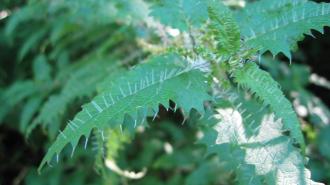The flora and fauna of New Zealand tend to be far less deadly than that in neighboring Australia. But the New Zealand tree nettle — or ongaonga — is one of the few poisonous plants native to the islands confirmed to have killed a person.
In 1961, two young men decided to spend their Boxing Day hunting in the mountainous Ruahine Range. The hunters stumbled into a dense thicket of ongaonga — stems and leaves bristling with toxin-bearing stinging hairs — getting stung all over their limbs.
Within hours, one was laboring to walk and breathe; he would go blind before succumbing to the tree’s toxins five hours later.
With this fearsome anecdote on its record, Australian researchers have naturally turned to the ongaonga for clues into how to combat pain.
The ongaonga is one of the few poisonous plants native to New Zealand confirmed to have killed a person.
Turning to toxins: In an effort to find new ways to combat pain — without the negative side effects and addiction potential of current methods like opioids — researchers around the world have been looking into the complex chemicals found in nature’s numerous venoms and poisons.
Scientists at the University of Queensland’s Institute for Molecular Bioscience (IMB) have been searching for molecules that can work on the body’s pain pathways in new, different ways.
And the ongaonga certainly knows how to impact the body’s pain pathways.
Stings can cause irritation, itching, pain, numbness, and pins and needles. A severe case can lead to much more dramatic symptoms, including difficulty breathing, loss of sight, weakness, and — weirdly — the production of way more saliva than usual. This can last for days to weeks, the researchers wrote in their study, published in the Journal of Biological Chemistry.
But according to the researchers, the toxins behind this buffet of misery had not been identified, and plant toxins are a whole new world for painkiller hunters to explore.
“Animal venoms have been studied for decades but plants have evolved toxins differently, and this gives us a chance to find molecules that work in a unique way,” Irina Vetter, director of the IMB’s Centre for Pain Research, said.
Australian researchers have, naturally, turned to the ongaonga’s toxins for clues into how to combat pain.
A new way to cause pain: The researchers found two types of toxins they believe are responsible for the nettles’ nasty touch.
One is a toxic protein that causes pain by messing with cell membranes.
The other is a new class of neurotoxin that affects an important part of cells called voltage-gated sodium (NaV) channels. These channels are crucial to the cells functioning properly, and the team believes that this neurotoxin may be responsible for the ongaonga’s body-wide symptoms.
Both toxins represent new ways to attack the body’s pain pathways — and therefore new ways to understand, and potentially treat, pain.
The researchers had previously analyzed the ongaonga’s Aussie relative, the Gympie-Gympie, which causes severe and long-lasting pain. (Making it the perfect plant for Australia.)
In the Gympie-Gympie, the team also found an entirely new class of toxins, which they dubbed Gympietides, that they hope to be able to use as the basis for new therapies.
Even though it is related to the Gympie-Gympie, the team found that the ongaonga’s toxins take aim at the same targets but in an entirely different way.
“We discovered that the New Zealand nettle tree toxins target the same receptor as their Australian counterparts, but they cause pain in a different way,” Sam Robinson, a research fellow at the IMB, said.
“The Australian stinging tree and New Zealand tree nettle are both members of the nettle family, but separated millions of years ago and have evolved differently.”
“Our goal is to tackle pain more effectively without side effects and addiction.”
Irina Vetter
The researchers theorize that the ongaonga evolved its unique toxins to keep itself safe from the moa, an enormous flightless bird — now extinct — once native to New Zealand.
Understanding all of these new pain pathways could be crucial to finding new ways to treat chronic pain, Vetter, the Centre for Pain Research’s director, said.
“Our goal is to tackle pain more effectively without side effects and addiction.”
We’d love to hear from you! If you have a comment about this article or if you have a tip for a future Freethink story, please email us at tips@freethink.com.
